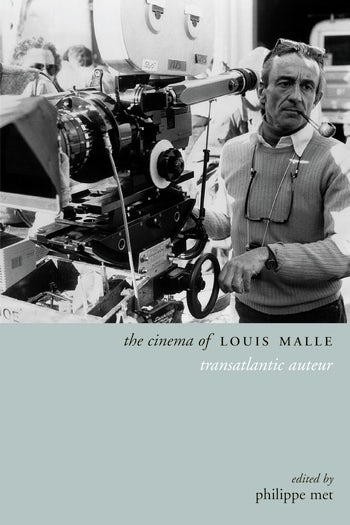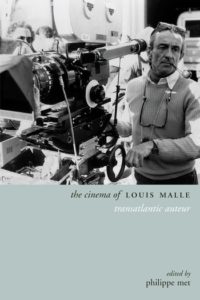
 With a career that reached from Paris to Hollywood, from documentary to fiction, from the French New Wave to late surrealism to classic narrative cinema, Louis Malle (1932-1995) was one of the most versatile, provocative, and independent directors of the postwar period. Many readers will remember, perhaps, the uncomfortable exploration of French collaboration revealed in Lacombe, Lucien; the heart-wrenching story of a Catholic boys’ school that protected Jewish children during the Second World War told in Au revoir les enfants (1987); the playful, innovative editing in Zazie dans le métro (1960); or the dark, moody score that Miles Davis wrote for Elevator to the Gallows (1957). But I wonder how many people have actually seen all of the Malle films. And if you have, how do you make sense of the totality of this eclectic, dazzling, and endlessly innovative body of work? The contributors to The cinema of Louis Malle: Transatlantic Auteur have, and their collective scholarship proposes a rich and multilayered set of approaches to the work of this rigorous and elusive director.
With a career that reached from Paris to Hollywood, from documentary to fiction, from the French New Wave to late surrealism to classic narrative cinema, Louis Malle (1932-1995) was one of the most versatile, provocative, and independent directors of the postwar period. Many readers will remember, perhaps, the uncomfortable exploration of French collaboration revealed in Lacombe, Lucien; the heart-wrenching story of a Catholic boys’ school that protected Jewish children during the Second World War told in Au revoir les enfants (1987); the playful, innovative editing in Zazie dans le métro (1960); or the dark, moody score that Miles Davis wrote for Elevator to the Gallows (1957). But I wonder how many people have actually seen all of the Malle films. And if you have, how do you make sense of the totality of this eclectic, dazzling, and endlessly innovative body of work? The contributors to The cinema of Louis Malle: Transatlantic Auteur have, and their collective scholarship proposes a rich and multilayered set of approaches to the work of this rigorous and elusive director.
Malle began his career in the late 1950s, right around the time that the New Wave exploded onto the French and international scene. Unlike Godard and Truffaut, who came to filmmaking as film critics, Malle trained at the Institut des hautes études cinématographiques (IDHEC), France’s premier film school. His early work was readily associated with the Wave, but he soon diverged stylistically and personally from the “Cahiers du cinéma gang” (6). He was intense, irascible, constantly reinventing himself: “all sensitivity and skin,” as fellow filmmaker Volker Schlöndorff remembers in the forward to this volume (4). The winner of an Academy Award and a Palme d’Or at age 24 for The Silent World (a documentary co-directed with Jacques Cousteau, 1956), Malle has received surprisingly little scholarly attention, at least when compared to the profusion of work on contemporaries such as Jean-Luc Godard, François Truffaut, Chris Marker, and Agnès Varda. There are substantial interviews, a French language monograph (Prédal 1989), a biography (Billard 2003) and two English-language monographs (Frey 2004 and Southern and Weissberg 2006). But The cinema of Louis Malle: Transatlantic Auteur, edited by Philippe Met and published in the well-respected Directors’ Cuts series at Wallflower Press, is a welcome addition to this relatively sparse bibliography. Neither introduction nor textbook, the book has much to interest film scholars, students, and cinephiles alike. The collection features a star-studded lineup of distinguished scholars (including Louis Malle’s daughter Justine Malle). It is “bookended” by a forward and afterward by the filmmakers Volker Schlöndorff and Wes Anderson, whose reflections provide a moving testament to what Malle’s work meant to his colleagues. It also includes previously unpublished texts by Malle himself: a film script for a never-realized project titled “The Loner” and inspired by Henry James’ 1897 novel What Maisie Knew; and the text of a lecture he delivered on board the ocean liner Queen Elizabeth 2 in the 1980s, in which he recounts anecdotes from his artistic and personal life.
The volume opens with the forward by Schlöndorff, who was a close personal friend of Malle’s as well as a collaborator on numerous films. Malle was clearly an inspiration to Schlöndorff, as he recounts in a portrait laced with stories and memories. He depicts Malle as fiercely competent and precise in his work (“as a soldier his gun, he knew cameras and sound equipment inside out,” 3) but restless and even lost in his personal life. The scholarly work of the volume begins with an informative and useful introduction by Philippe Met that presents some of the broader questions at stake in the current scholarship on this director. One of these is what to make of the dizzying range of Malle’s work—how to understand a career that includes works as disparate as The Silent World, Elevator to the Gallows and Atlantic City as well as a 1953 student film inspired by the Charlie Parker piece, Crazeology and a documentary about the production process in a Citroën automobile factory (Humain, trop humain, 1974). Is it ambivalence and inconsistency, as some critics continue to argue today? Or is it, as Met argues, a “deep-seated core of perpetual dissatisfaction (with his own achievements), an insatiable curiosity, […] an unflinching refusal to repeat himself” (6). Met proposes that we understand Malle as driven by intellectual curiosity and humanistic openness, first and foremost; secondarily by passion, and third by a sort of “existential restlessness” that drove him to seek out new projects and engage in constant self-reinvention (7).
The heart of the volume is divided into two main sections. First, it includes a collection of “transversal” chapters, each of which takes up a broad question traversing several of Malle’s films. One of the strengths of this section is the sustained attention to Malle’s documentary work. A richly documented piece by Guillaume Soulez on The Silent World and a collection of lesser-known short films portrays Malle’s admiration for, but also respectful divergence from, Jacques Cousteau and his team. A nimble and elegant chapter from Caroline Eades demonstrates the ways in which Malle’s documentary work bleeds into and informs his fiction filmmaking. Derek Schilling’s chapter mines contemporary criticism about two 1974 documentaries, as well as detail on production processes and distribution venues, for useful insights about audience expectation of documentaries based on their political leaning. Other highlights of this section include a contribution by Jean-Louis Potreau on jazz in Malle’s work, enriched by biographical detail about Malle’s discovery of and developing interest in jazz, as well as a detailed treatment of Malle’s collaboration with Miles Davis on Elevator to the Gallows. Ian Fleishman’s chapter on Zazie dans le métro and Black Moon is another standout piece; he traces the performance of Oulipian and surrealist automatism respectively in these works and brings precision to the distinction between these two processes that are often conflated when referring to Malle’s work. In this section, Michel Ciment also contributes a detailed and carefully parsed discussion of the right wing writers with which Malle interacted (including Drieu La Rochelle and Roger Nimier) that sheds helpful light on the ambiguities of these relationships.
The transversal chapters are followed by a collection of “monograph” chapters, each devoted to a critical analysis of one of the major films (The Fire Within, Le Voleur, Phantom India, Lacombe Lucien, Au revoir les enfants, Atlantic City, My Dinner with Andre, and Vanya on 42nd St). The omission of Elevator to the Gallows from this section seems odd given the importance of this work that is nonetheless addressed at various points in the transversal chapters. Still, this section contains a valuable array of new work on the films that will be of great interest to readers who have come to expect high quality, original and accessible scholarship from the Director’s Cut series. One of the highlights is Philippe Met’s chapter on Le Voleur, which offers a densely argued reading of a film that is in some ways Malle’s most autobiographical, although not in the literal sense, and yet is one of the films having received the least criticism. Ludovic Cortade’s analysis of the seven-part documentary Phantom India sheds new light on this project as a turning point in Malle’s career, and draws important and overlooked connections with his other documentary and fiction works. Other highlights include Tom Conley’s read of My Dinner with Andre as a “mystic event” ending in a “conversion”; Francesca Cinelli’s analysis of sound in Atlantic City complemented by an interview by Philippe Met of John Guare, the Academy Award-nominated screenwriter for the film; and Stephen Ungar’s characteristically rich and precise analysis of Lacombe Lucien’s reception. Placing Lacombe Lucien in conversation with Sartre, as well as with films such as Le chagrin et la pitié (Marcel Ophuls, 1969) and Au revoir les enfants, this chapter makes an important contributions to the long history of French cultural responses to the memory of war, occupation and collaboration.
In sum, this volume is as generous to film enthusiasts just coming to Malle’s work as it is to seasoned scholars. Critics and scholars will find a wealth of new biographical and critical detail, as well as new primary sources and an excellent introduction to the current state of debates on Malle and his legacy. Newcomers will gain insight into the wide-ranging talents and interests of this bicultural, bilingual director who successfully navigated the film industries in France and the United States. Readers who thought they knew Malle will find new perspectives on old favorites, and will likely be inspired to seek out a few of the works they might have missed. At the end of the volume, Wes Anderson’s afterword brings in the perspective of a younger filmmaker for whom the discovery of Malle’s work was decisive in his own creative trajectory. “Who else,” he asks, “has created a body of work so complete as Malle’s?” This sentence—the last word in the book—is a fitting coda to a volume that is rich, eclectic, and exacting, fitting indeed for the work of the director in question.
Reviewed by Alison J. Murray Levine, University of Virginia
The Cinema of Louis Malle: Transatlantic Auteur
Edited by Philippe Met
Publisher: Wallflower Press
Paperback / 272 pages / 2018
ISBN: 9780231188715
To read more book reviews click here.
Published on March 5, 2019.




